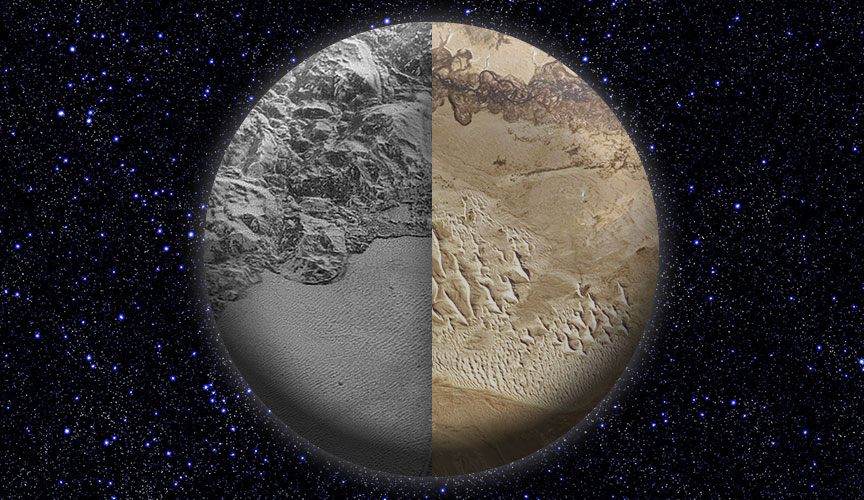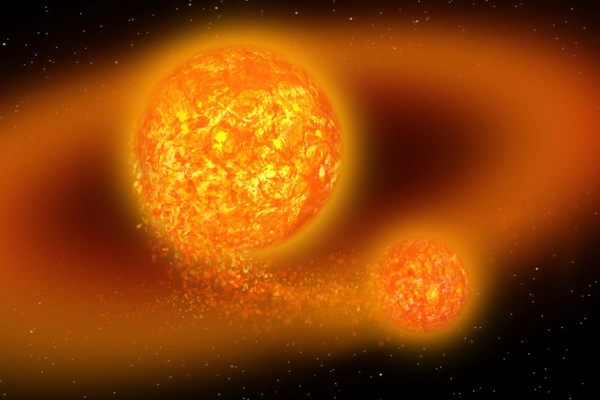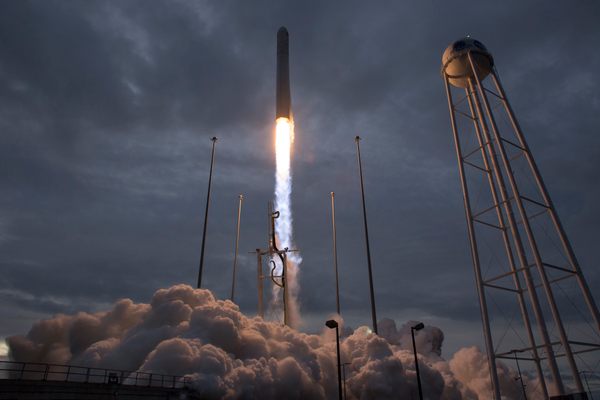How Comparisons Help Us Understand the Universe
And ourselves.

The other night, a few minutes after 8:30 p.m., I went outside and lingered. The surroundings were familiar—the freshly flickering bodega signs, the clusters of people and dogs, the bricks blazing when the sun slants just so on its descent. The sky didn’t look especially alien, either—I often extend my walk home in order to glimpse the world washed the color of a muddy puddle, to stand inside the blue-black darkness just beginning to fall.
But on this particular evening, I wasn’t outside to bask in the bodega golden hour. I was trying to approximate the feeling of high noon on Pluto.
This goes without saying, but: Pluto is not Brooklyn. It is cold; it is dark; it is 4.67 billion miles away. Its differences are legion, and the starkest among them are hard to even imagine. No matter what image I squint to conjure—a body freckled with ice cubes, snow drifts pinning me down—the concept of a temperature sliding to -387 degrees Fahrenheit does not compute.
I’ve never been that cold. Neither have you. But we have both seen twilight, or the moments just after it, and that’s not a bad approximation of what Pluto looks like at its brightest. To help Earthlings imagine life there, NASA has created a website called “Pluto Time.” You plug in your address, and it spits out the exact moment, at that particular longitude and latitude, that the sky above you most resembles the one above Pluto. Any number of other, distinctly-Earthly sensations might jostle for your attention—you may hear wheezing buses or smell meat cooking on a street cart—but visually, you’ll have a proxy for our far-flung solar neighbor.

Space is vast and alien. That’s one basis of its romance, but it’s also a cognitive hurdle for anyone trying to wrap their head around its reaches. “The trouble we normally have with space is, if we try to understand something, we only have one example—our own planet,” says Colin Stuart, a fellow of the Royal Astronomical Society and the author of the forthcoming How to Live in Space: Everything You Need to Know for the Not-So-Distant Future.
A solipsistic view isn’t necessarily a bad thing, he says: Using Earth as a data point is often helpful—especially for science educators trying to connect with enthusiasts who aren’t fluent in astronomical jargon. “We always try to compare things to Earth when we can,” Stuart says. “If you’re starting with something they know about, you’re not starting from the beginning.” He stacks up volcanoes, valleys, and trenches in space against the Grand Canyon or Everest, “because people have that frame of reference,” even if the features are on vastly different scales. (Olympus Mons, the highest of Mars’s volcanic peaks, is 2.5 times taller than Everest, and roughly the width of France.)
“Unless you’re embedded in the science speak, I could be saying any kind of gobbledygook, but that might not make any sense to anyone,” says Michelle Nichols, the director of public observing at Chicago’s Adler Planetarium. Nichols often translates features of space that might otherwise be somewhat inscrutable into familiar scenarios or childhood games. She compares sun spots, as glimpsed through a telescope, to iron filings dancing under a magnet’s sway. “People remember doing that,” she says. “They go, ‘Right, now I see it.’”

To some extent, scientists lean on analogues in peer-reviewed papers, too. In a recent paper in Science, a team of researchers including Jani Radebaugh, a planetary scientist at Brigham Young University, and her collaborator Matt Telfer, a physical geographer at the University of Plymouth, reported on Pluto’s dunes, which look something like the ones on Earth’s deserts or beaches. A lay viewer glancing at the images captured by the New Horizons spacecraft might not have made the connection, but an analogue can turn on a lightbulb. “They may only see a whitish background with some squiggles,” Nichols says. “As soon as you say, ‘It’s like a sand dune,’ they say, ‘Oh, wait a minute! I’ve been to the Indiana dunes, I’ve seen pictures of the Sahara.’” Pluto’s drifts aren’t sand—they’re slopes of frozen methane—but the wind has sculpted them into similar shapes, and that knowledge may give laypeople a foothold.
The same goes for radar maps of Titan, one of Saturn’s moons, says Stuart. The maps reveal a smattering of islands, archipelagos, and peninsulas, and Stuart thinks “if you put a radar map of Titan next to a map of the Scottish coastline and you made them the same colors—no giveaways about what was blue and green—you’d struggle to tell them apart.” Canada would work, too, he adds, “anywhere there’s jagged coastlines with islands and inlets.” Analogues can collapse some of the psychic distance between Earth and space without making the latter seem any less fascinating.

Still, analogues aren’t always apt. “Many decades ago, we weren’t sure what the surface of Venus was like,” Nichols says. Through telescopes, the planet seemed completely shrouded in clouds, and since researchers didn’t know what was happening beneath them, some speculated that the landscape was steamy—maybe speckled with water or tangles of jungle. The first half of the 20th century gave rise to a smattering of sci-fi novels and comics that pictured Venus thick with carnivorous plants and crawling with swamp-loving lizards. “Turns out it was 100-percent incorrect,” Nichols says. “We learn more, we go, ‘Oh wait, that whole 870-degree surface temperature, that might not be so good for life there.’”
No harm done. The real trouble with analogues comes, Stuart says, when they overstate the case and then gain traction. Then, they run the risk of oversaturating people’s curiosity to the extent that, when a really striking comparison does arise, listeners are unimpressed. He thinks this is especially dangerous with exoplanets—those distant orbs that we haven’t yet seen up close. “There have been loads of headlines over the last few years about astronomers finding Earth-like planets in other solar systems,” Stuart says. The phrasing drums up enthusiasm and establishes the stakes; Stuart says press releases and articles about research sometimes “torque it up” to make the findings newsworthy and relevant to readers.
“The trouble is, we don’t know how Earth-like [those planets] are,” he adds. Researchers know that some planets are comparable in size to our own, and that they may have similar temperatures, such that if water was present there, it would likely be liquid. But that’s a big “if,” he adds, and the distinction is crucial. “The danger is, if we keep doing this ‘Earth-like planet’ thing, and we get to the place where we do find an Earth-like planet with liquid water and an atmosphere with oxygen, people aren’t necessarily going to care as much as they should,” he says. “They’ll be bored of it, I think.”
For some researchers and astronauts, analogues go far beyond language. A handful of research stations on our planet recreate the conditions of various environments in space. For the past few years, Earth-locked crews have set up dome camps on top of Mauna Loa, a volcano on the island of Hawaii whose ruddy soil looks something like the rugged terrain of Mars. In a program organized by the University of Hawaii and backed by NASA, the team strove to live like human Martians. They ate middling food, they slept and relieved themselves in cramped quarters, they were isolated from friends and family. Here, Earth was a dress rehearsal.
Last winter, one of the practice runs went wrong. After a medical emergency, the whole thing was suspended, pending investigation. “We’ve learned all the ways that you can kill yourself on Mars, and we’ve learned to prevent those things,” Bill Wiecking, one of the project’s support leads, told Marina Koren at The Atlantic. “So it’s been very, very valuable, because it’s way better to do it here, where you can drive up and go, oh gosh, a water valve opened up and now you don’t have any water. Instead of on Mars, where it’s like, you don’t have any water, you guys are gonna die in a couple of days.” Instead of highlighting the similarities between our worlds, the analogous experiment emphasized how much we still don’t know about how to function elsewhere.

Even as analogues give us a way to make sense of space, they also shed light on Earth. When we tell ourselves a story about the cosmos, we’re revealing something about what’s preoccupying our own planet at the time. That was especially obvious in the 19th century, when Percival Lowell and other astronomers, no doubt steeped in the “canal mania” that was churning around the Erie and Suez channels, suggested that Mars was shot through with artificial waterways carved out by intelligent life. “Given these developments, it’s perhaps not surprising that Lowell and many of his contemporaries were quite open to the idea…that canals might exist on the most Earth-like planet in the solar system,” writes Klaus Brasch, a professor emeritus of biology at California State University, in Sky & Telescope magazine. The view through the telescope reflected something about life here on the ground, because we couldn’t blink it away.
Curiosity aside, most of us don’t need to know exactly what Pluto, Mars, or the Moon are like—we don’t need to practice skills to survive on the ground there, because we’ll probably never need to. If our jobs or lives don’t depend on understanding the features of a far-off world, the equivalences between Earth and a distant planet may seem like nothing but nuggets of trivia. They’re more than that, though: Thinking about another world helps us find hidden reserves of wonder in our own. Analogues remind us that space “is a weird place,” Stuart says. But “it’s not that weird, because it’s also eerily familiar.”
Mary Roach, the science writer and author of Packing for Mars: The Curious Science of Life in the Void, was animated when she told me about reporting on Devon Island, another physical analogue that scientists use to simulate off-world missions. She was bouncing along the Canadian island’s rugged, remote terrain on an ATV, tagging along as crews rehearsed for a two-vehicle expedition. The environs were mesmerizing—vast and monochromatic, flecked with a few tiny flowers and a single bumblebee. “I was like ‘Yeehaw!’” Roach says. “It was fun to be tooling around on an ATV in this landscape, and going around thinking ‘I could be on the moon.’ It was kind of exhilarating and fun and starkly beautiful.” Simultaneously familiar and appealingly, wondrously, comfortably strange.

















Follow us on Twitter to get the latest on the world's hidden wonders.
Like us on Facebook to get the latest on the world's hidden wonders.
Follow us on Twitter Like us on Facebook